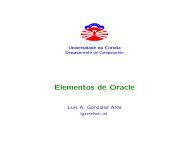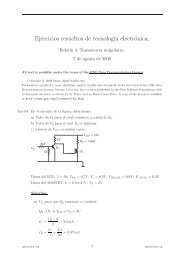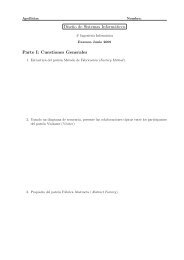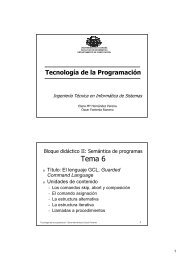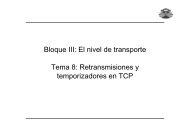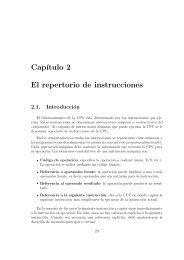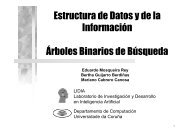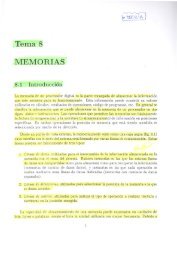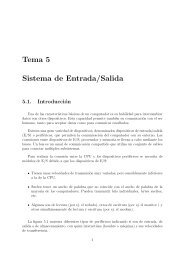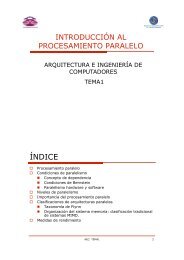repaso de fundamentos matemáticos - QueGrande
repaso de fundamentos matemáticos - QueGrande
repaso de fundamentos matemáticos - QueGrande
Create successful ePaper yourself
Turn your PDF publications into a flip-book with our unique Google optimized e-Paper software.
PÁG. 18 DE 24 TEMA 0: REPASO FUNDAMENTOS MATEMÁTICOS<br />
P) La diferencial total permite hallar el cambio completo <strong>de</strong> la función cuando se modifican<br />
ligeramente los valores <strong>de</strong> todas las variables <strong>de</strong> las que <strong>de</strong>pen<strong>de</strong>.<br />
EJEMPLO 0. 28: Contestando a la pregunta final planteada en el Ejemplo 0. 27, obtenemos<br />
2<br />
EK<br />
EK<br />
v<br />
dEK<br />
= dm+ dv = dm+<br />
mvdv<br />
m v 2<br />
(T0. 38)<br />
Este cambio específico se expresa en Julios.<br />
La <strong>de</strong>finición pue<strong>de</strong> exten<strong>de</strong>rse a funciones <strong>de</strong> muchas variables. Por ejemplo, si y <strong>de</strong>pen<strong>de</strong> <strong>de</strong> N<br />
variables x 1 , x 2 , …., x N , la diferencial total <strong>de</strong> w es:<br />
N<br />
y y y y<br />
y = yx ( , x ,..., x ) Þ dy = dx + dx + ... + dx = dx<br />
1 2 N 1 2<br />
N n<br />
x1 x2<br />
xN<br />
n=<br />
1<br />
xn<br />
å<br />
(T0. 39)<br />
PREGUNTA: ¿Cómo se lee esta fórmula<br />
En esta asignatura sólo trabajaremos con funciones <strong>de</strong> hasta 3 variables in<strong>de</strong>pendientes.<br />
0.2.9. INTEGRAL INDEFINIDA (FUNCIÓN UNIVARIABLE)<br />
Q) ¿Qué es La integral in<strong>de</strong>finida es la operación inversa <strong>de</strong> la <strong>de</strong>rivada. Por eso también se la<br />
<strong>de</strong>nomina anti<strong>de</strong>rivada.<br />
EJEMPLO 0. 29: Si tienes una función g(x)=cos(x), piensa que g es una función que ya está <strong>de</strong>rivada;<br />
entonces, pregúntate: ¿Cuál es la función f(x) que tengo que <strong>de</strong>rivar para obtener g(x) En este caso ya<br />
conoces la respuesta: f(x)=sen(x), porque df(x)/dx=cos(x)=g(x). En realidad, es cualquier función<br />
sen(x)+constante, puesto que al <strong>de</strong>rivar una constante obtienes cero, es <strong>de</strong>cir:<br />
f(x)=sen(x)+CÞdf/dx=d[sen(x)]/dx+dC/dx=cos(x)+0=cos(x). (T0. 40)<br />
C) ¿Cómo se representa y cómo se calcula<br />
La integral in<strong>de</strong>finida se representa con una S alargada (∫) a la izquierda <strong>de</strong> la función a integrar y un<br />
diferencial a la <strong>de</strong>recha, que indica respecto <strong>de</strong> qué variable hay que integrar:<br />
Integrando (función a<br />
integrar)<br />
Función primitiva (solución)<br />
ò<br />
Variable <strong>de</strong> integración<br />
[ ( ) + C]<br />
æ<br />
dFx<br />
ö<br />
f( x) dx = Fx ( ) + C <strong>de</strong> tal manera que = f( x)<br />
ç ÷<br />
è<br />
dx ø<br />
(T0. 41)<br />
Constante<br />
J. BRÉGAINS APUNTES COMPLEMENTARIOS DE FMC




